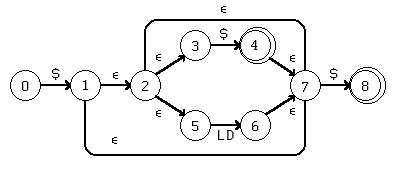Module 3 Exercises
-
Write regular expressions for:
-
Real numbers that include those represented by the following examples:
0.3, 3.0, 1.52, 0.5E-1
-
Identifiers that begin and end with $ and have any number of letters, digits,
and $ in between.
-
Relational operators as expressed in:
-
C: ==, !=, <, <=, >, >=
-
Pascal: <,>, =,<>, <=, >=
-
FORTRAN: .LT., .GT., >EQ., .NE., .LE., .GE.
-
Ada: =, /=, <, <=, >, >=
-
A language of your choice
-
The driver algorithm in Section 3.2 is missing
many details. For example, the issue of blanks needs to be addressed. Extend
the algorithm to ignore blanks and to:
-
Use blanks as a delimiter within the strings, that is, finding a blank
denotes the end of the current token.
-
Allow blanks within tokens, that is, Max1 is the same token as Max 1.
-
Example 3 shows a partial table for recognizing
an identifier consisting of letters and digits beginning with a letter.
Since neither letter nor digit is a single character, more details need
to be provided. Traditionally there have been two methods. Discuss what
these might be (and then check the answers to selected exercises).
-
Show a CASE statement equivalent to the table in Example
3.
-
Write the details of the four actions GetChar, Accept, Retract, and Return
from Section 2.
-
From the method described in Section 3.3.1 write
an algorithm to convert from an from a regular expression to a NFA. Describe
the NFA as an abstract data type, rather than deciding upon a particular
implementation such as a table or CASE statement.
-
Using the method described in step 2 of Section
3.3.2 , write an algorithm to convert from an NFA to a DFA, again describing
each of the NFA's as an abstract data type.
-
Using the method described in step 2 of Section
3.3.3 , write an algorthm to convert from DFA to a minimal DFA, again
describing each of the DFA's as an abstract data type.
-
Implement an NFA (as described in Exercises 6 and 7) as (a) a table and
(b) a CASE statement.
-
Name some applications where it would be better to do the extensive work
required to write a lexical analyzer generator, rather that writing a lexical
analyzer and then making changes to it when needed.
-
Is the LEX grammar unstratified? You will need a LEX manual to answer this.
-
The table in Section 3.3.1 1 step (d) is incomplete.
Add the missing information.
-
Convert the following to a DFA.

Solution
-
Convert the following to a minimal DFA.
|
|
a
|
b
|
|
>A
|
B
|
A,D,F
|
|
B
|
|
C,F
|
|
C
|
A
|
G,D
|
|
D
|
E
|
E,D,H
|
|
E
|
|
F
|
|
*F
|
|
D,H
|
|
G
|
B
|
G,D,H
|
|
*H
|
|
|
Solution
 Send questions and comment to: Karen Lemone
Send questions and comment to: Karen Lemone

 Send questions and comment to: Karen Lemone
Send questions and comment to: Karen Lemone